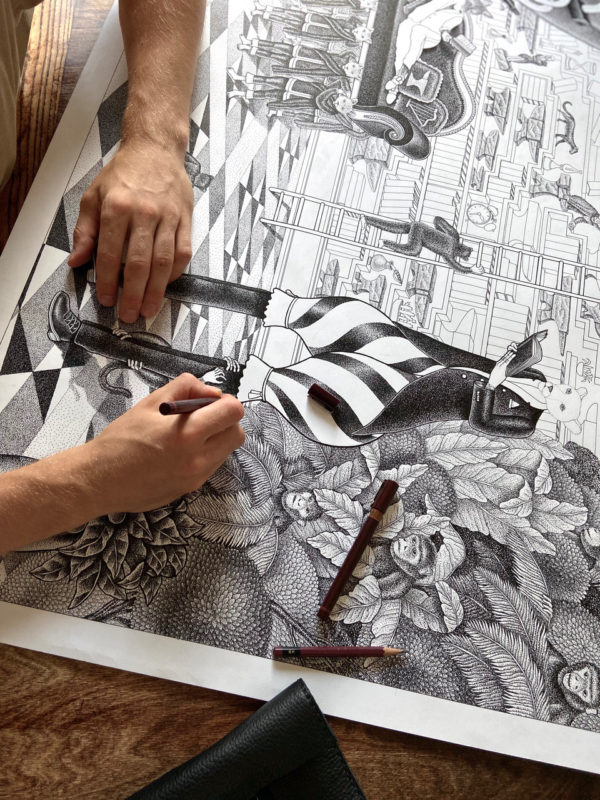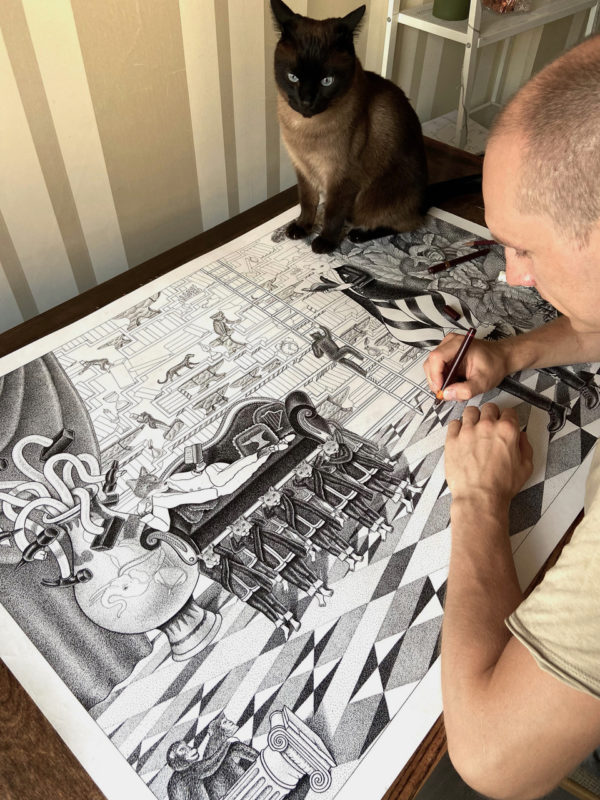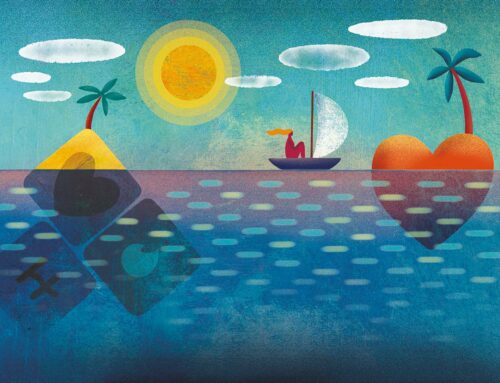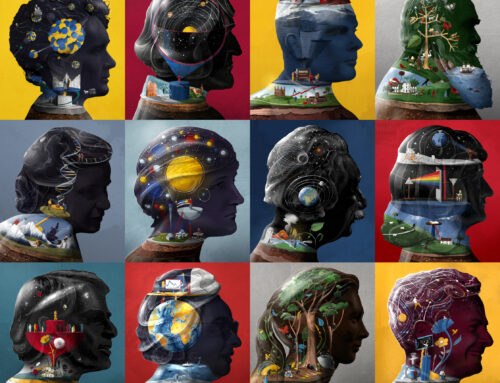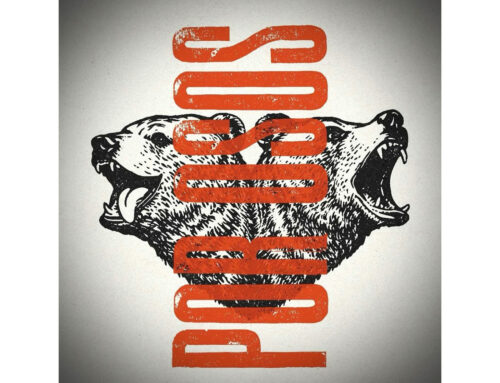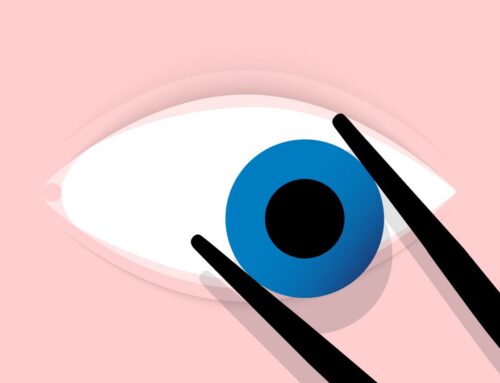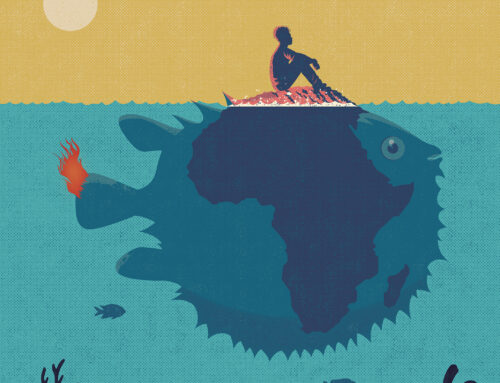Interview with Dima Kashtalyan – Illustrator, fine artist and muralist
1. Where do you find your inspiration?
The answer to this question is too big. I will try to answer shortly. I can find an inspiration everywhere and it can happen at any time. What can affect my inspiration is mental stress. I try to devote time to reading books, listening to lectures on various topics, watching films and listening to music. I try to communicate with interesting people with whom I can discuss and in the process learn something new and enrich my inner world. I can be inspired or prompted by a thought or idea, a phrase from an article, book, a song. I can see an ordinary object, like a chandelier for example, and the thought comes to me that it looks like a drone and it would be great to create a plot with that image. I think about what can I communicate with that. This can take place in parallel with work on other tasks and a solution will be formed in my head may be even a month later, or maybe in just half an hour. Inspiration is everywhere around us, since the world is huge and multifaceted, it is important to look around more carefully, listen to others and yourself, and to go beyond the boundaries of the usual daily routine.
2. What is your process of work, from your original idea, to the choice of medium and surface to the finished piece?
Any of my stories always begins with a long preparation. The foundation can be an object or symbol that I want to develop into something more, or an idea, some kind of phrase that I gradually transform in my head into suitable symbols and objects. The idea is always important to me and what I am illustrating for. It is important for me to understand that it has some meaning and a dialogue with the viewer. Therefore, a large amount of time is taken up by the thought process and the selection of potential images for solving the task. It is important to find one or more key episodes, characters, objects on which I want to build my story in the illustration. When they are found, I select a suitable format for the composition and start sketching, including key images in them. Gradually, I understand whether they work or not and change if necessary. Next, I add various small details that are also very important. When all the necessary elements and their intended appearance have been found, I make a final sketch. The next stage is the transformation of the sketch into a finished work, which at the very end can be edited if it is a digital illustration. If I draw graphics exclusively on paper, then I do not have the opportunity to edit it at the end, I must immediately do it at the highest quality.
3. What concepts/message would you like to convey in your work, or a specific work you would like to discuss?
I like to illustrate different concepts and talk about different actual questions. It depends on my life period, my inner world at the moment, question that are interesting for me at that moment and I look for an interesting way to show it. There is a difference depending on whether I draw my personal idea or whether I need to illustrate some idea or task for a customer. I can use as an example the graphics on which I am currently working for an author. This work is a diptych in which I talk about education, especially self-education and the formation of oneself as a person. I am interested in this issue and I consider it very important both for each person individually and for our civilization as a whole. In my work, I argue how complex and continuous this process is. I think about the fact that you always need to work on yourself, otherwise you start to degrade and you can go down to a very low level – close to a wild animal. In my illustration, I am talking about the fact that some people, despite everything, are learning and are better today than they were yesterday. In contrast to this, the mass of people indulge in their laziness, complexes and wild instincts, continuing to stagnate, destroy themselves and the world around them. In addition to this work, I reflect my condition and life changes in other small personal works. To a large extent, all my works of authorship are directly related to myself and my life. They reflect my feelings, the way I think and live.
4. Why did you move from murals to illustration
Good question. I started my way in drawing and illustration with classic graffiti and drew fonts and simple characters on the walls. in parallel with this, I have always drawn sketches to one degree or another. At some point, I stopped drawing fonts and focused entirely on the characters and some author’s subjects. Illustration and studio drawing fascinated me with the fact that there is more time in the illustration for the embodiment of my idea. There are more opportunities to work out in detail and with high quality what you want to express and at the same time the work will live longer than on the street. Also, the illustration allows you to work from anywhere in the world and earn money without even leaving your home. True, I still love to draw murals and I do it when there is a suitable opportunity. I think this passion will remain in me for the rest of my life. These are special sensations that I refer, among other things, to the unforgettable moments of my youth associated with graffiti. At the moment, I alternate between commercial illustrations, author’s studio work and painting on the walls. The change in activity in creativity also has a productive effect on the process of drawing and the emergence of inspiration about which you asked me. Working on completely different tasks, different formats of implementation, traveling on creative trips is also an important engine of inspiration.
5. What is the most exciting project you have worked on?
At different stages of my creative life there were different exciting projects. As a rule, this would be something that has not been done before, something more than usual, something that would take me to a new level of creativity. Once upon a time it was the first commercial order in the author’s technique for a foreign customer. Also, the participation in international competitions and exhibitions when I can interact with other creative people and exchange experience with them. It was once the first painting on the wall abroad while on vacation. I also recall with joy my participation in major projects related to painting on the walls. The last of such projects were two consecutive participation in international street art festivals at the Street Art Museum in St. Petersburg and Nizhny Novgorod, Russia. As part of these projects, I drew three large murals. But the most impressive thing was that I lived and worked with dozens of other artists and creative people. Thanks to which I found new friends, received an invaluable exchange of creative and life experience. This is priceless and that is why I like to participate in various international creative projects.
7. Is your cat your lucky charm? 🙂
To some extent, yes. My cat is my little companion. He makes my life kinder and more fun. He respects my creativity and loves to watch it. Thanks to my cat, I even came up with an idea for an illustration. As I lay on the floor and played with it, I noticed a chandelier above me that looks like a drone. I mentioned this in the question about ideas and inspiration. I thought that the drone is an interesting object to illustrate and looking at a cat who is quite lazy like all cats, I decided to depict on the drone the same lazy birds as my cat, who do not want to flap their wings and use instead the drone for travel. It turns out that my cat is my co-author and, besides, it is also anti-stress, which is simply irreplaceable in modern life.
Enjoy the video (below) about Dima’s work and process:


